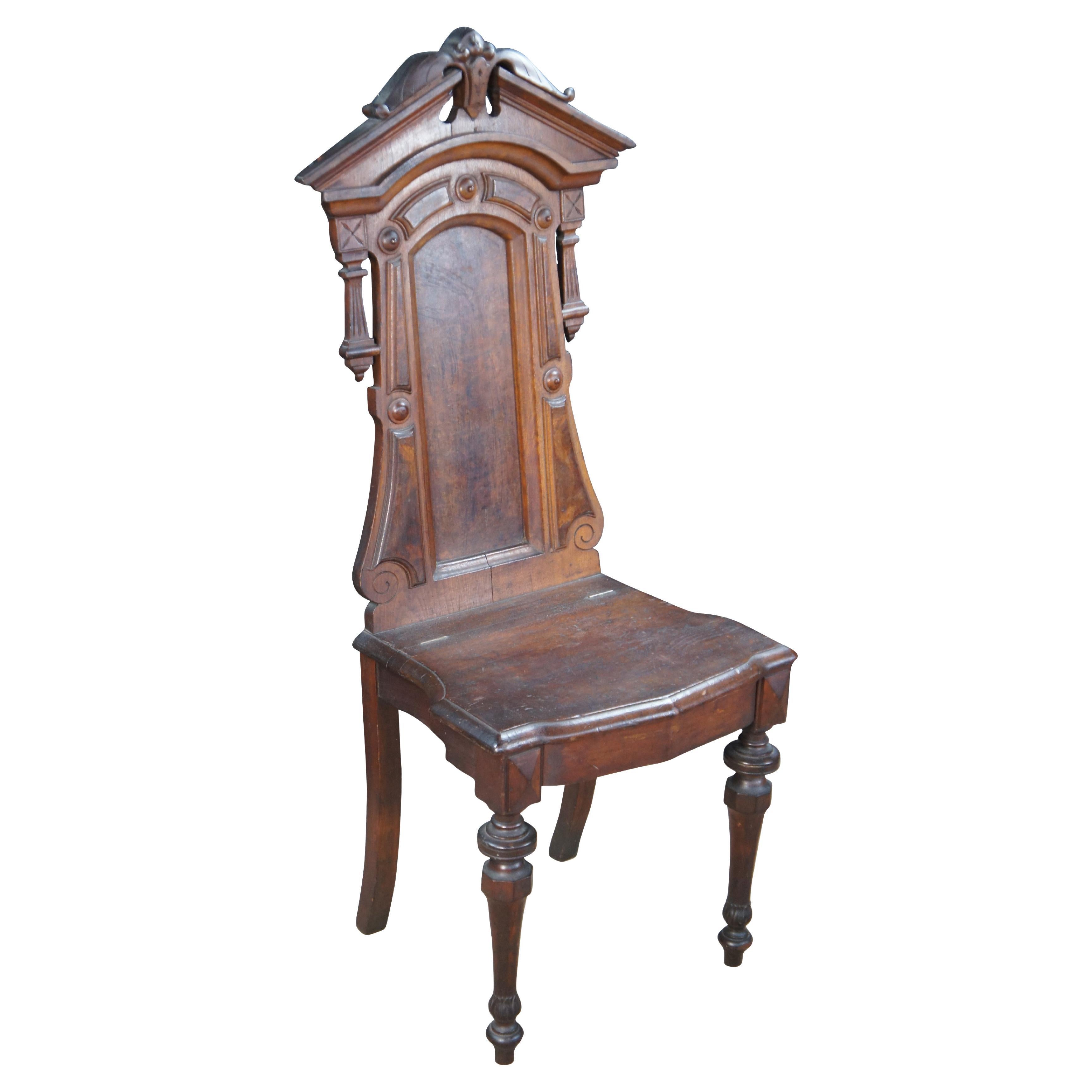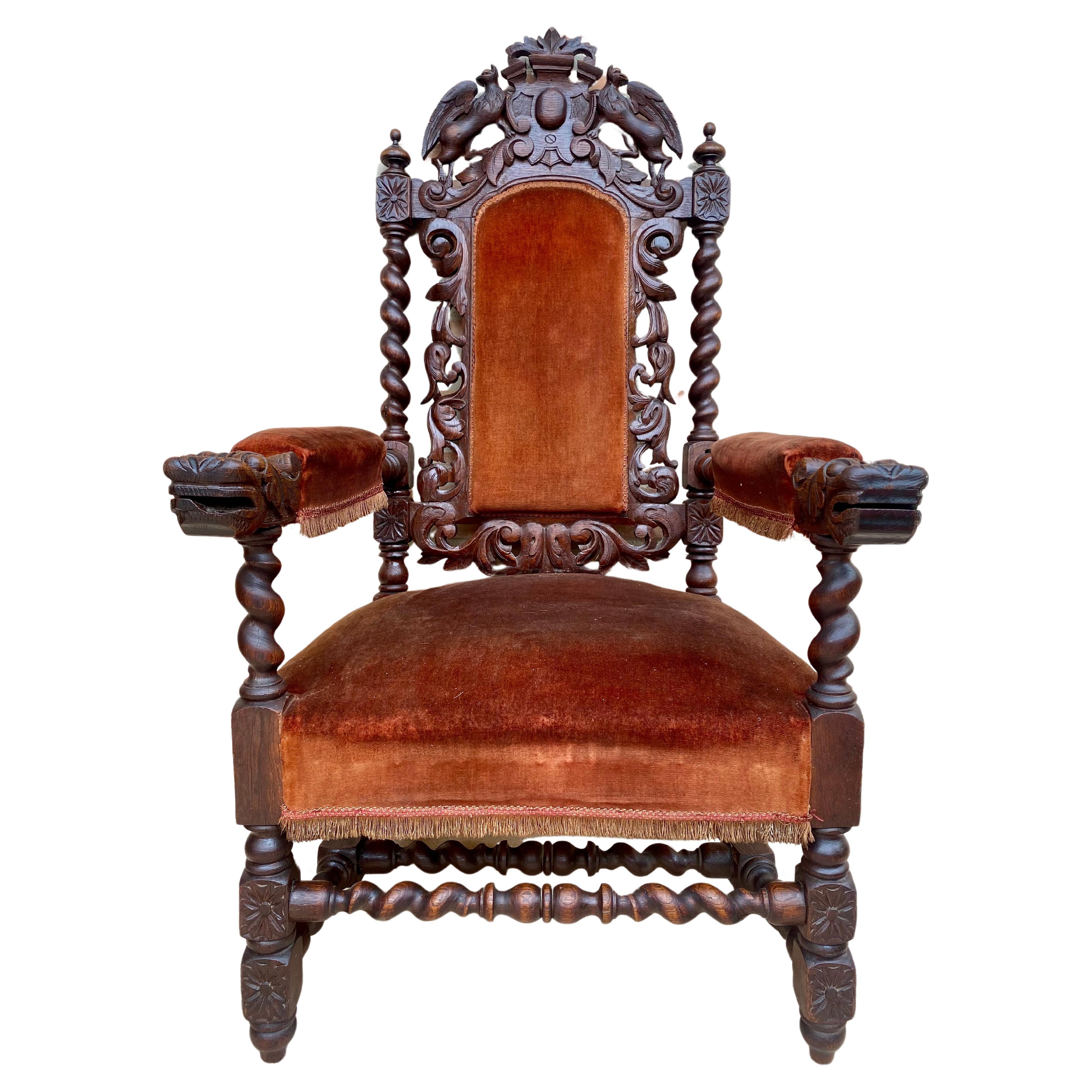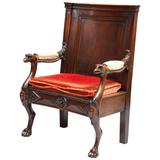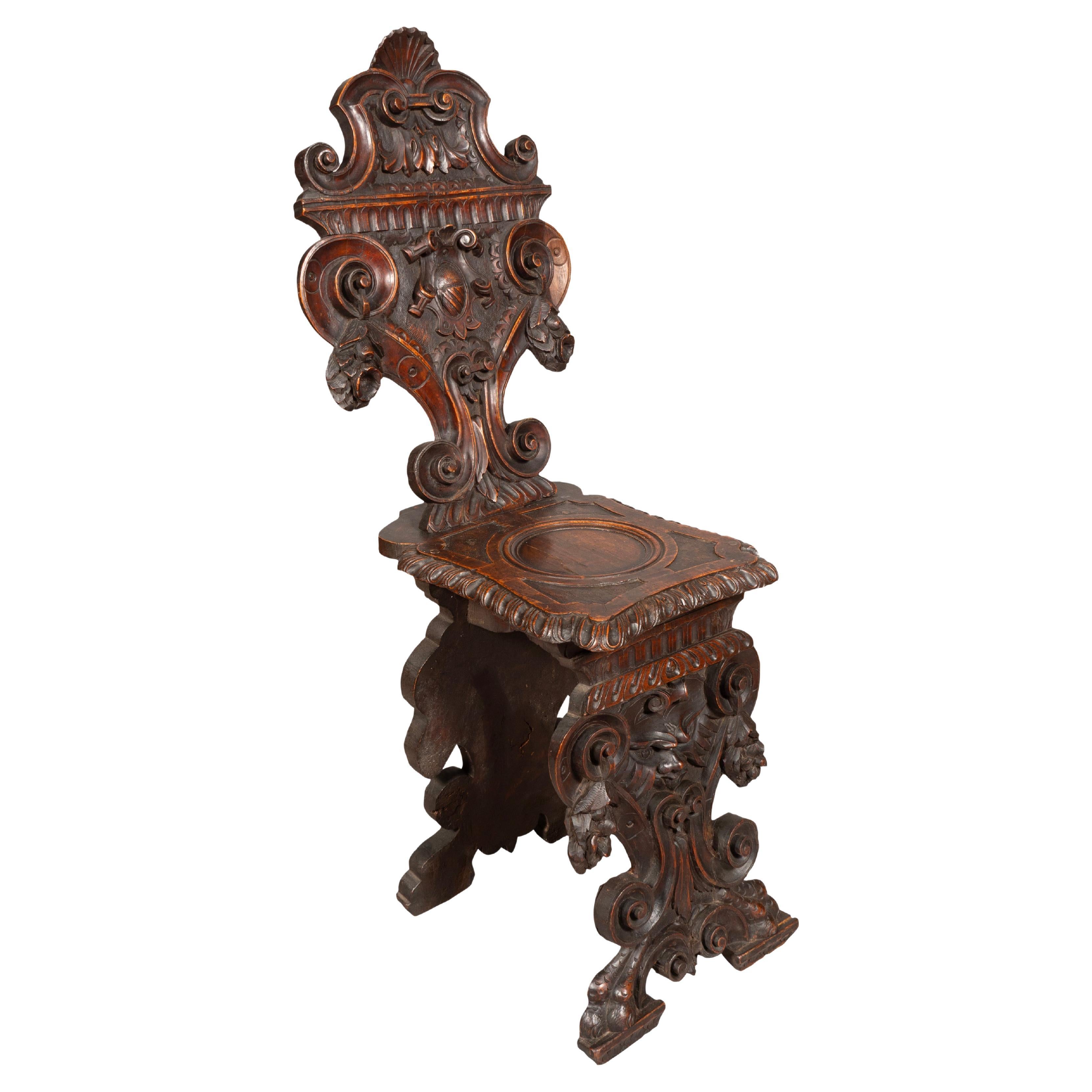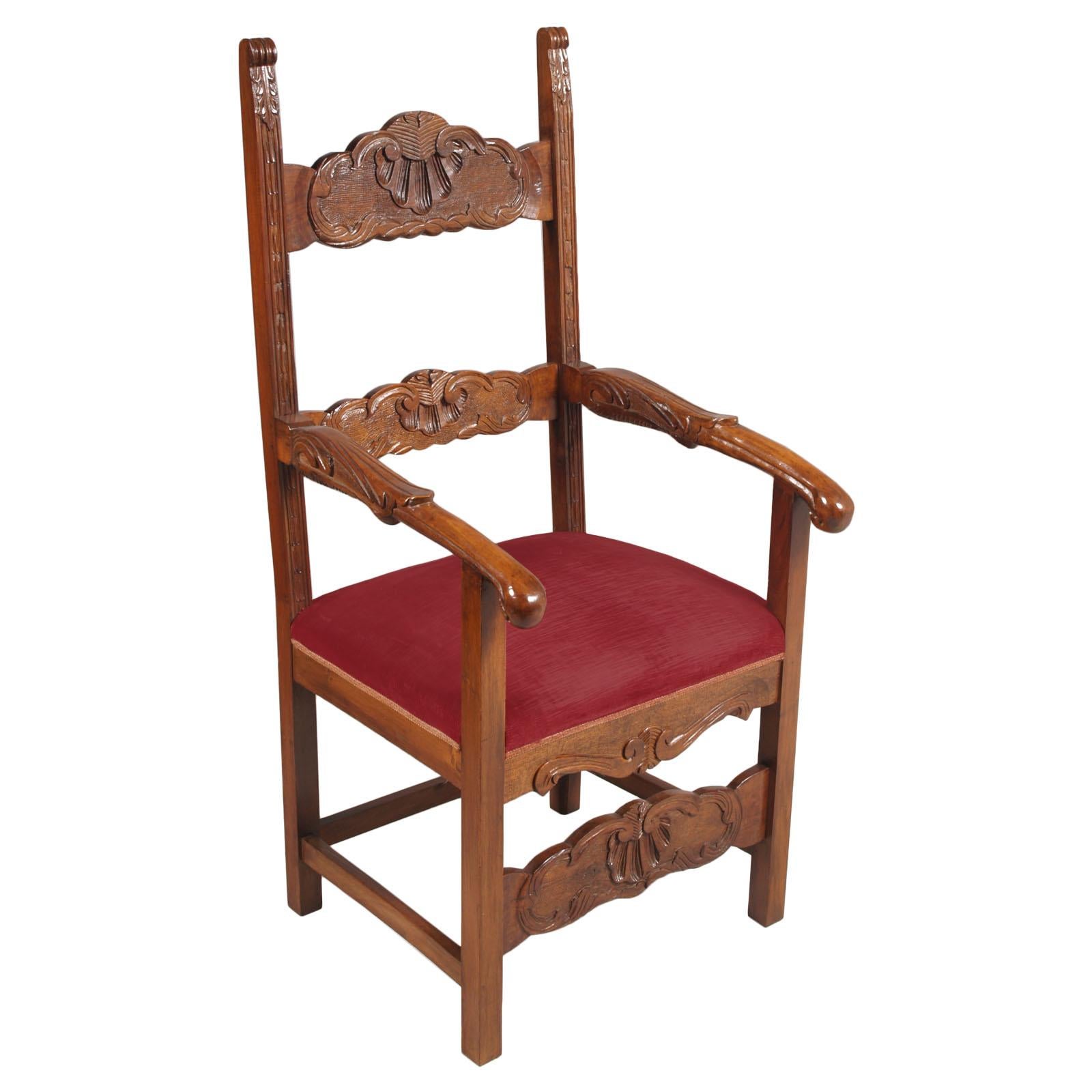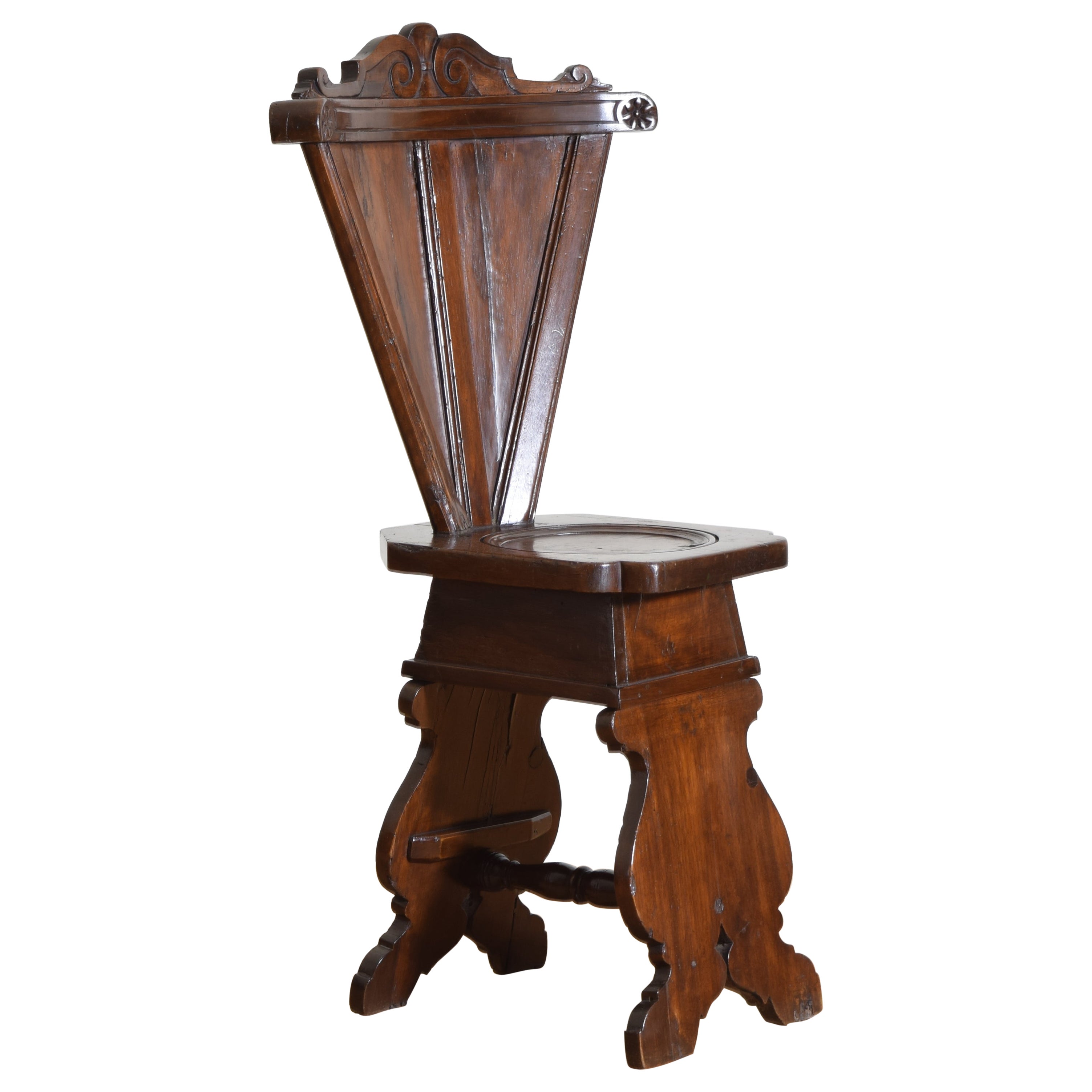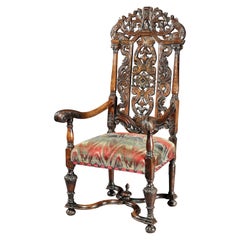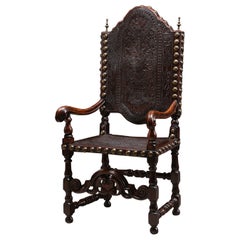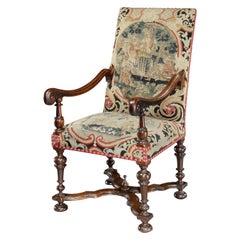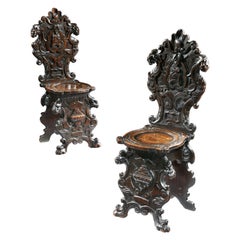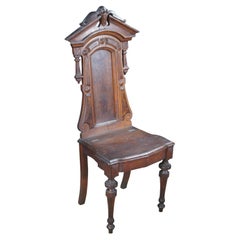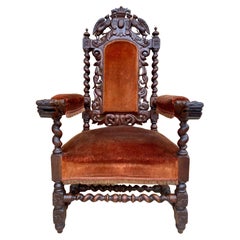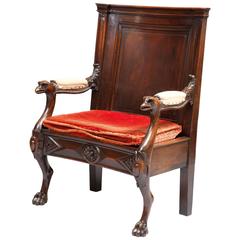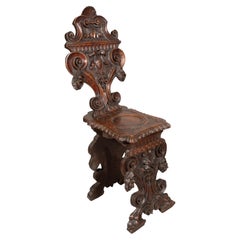Items Similar to Cathedra or Throne Chair, Late 16th Century, French Second Renaissance, Walnut
Want more images or videos?
Request additional images or videos from the seller
1 of 15
Cathedra or Throne Chair, Late 16th Century, French Second Renaissance, Walnut
$27,655.24
£20,000
€23,568.46
CA$38,317.72
A$41,605.60
CHF 22,033.21
MX$509,965.43
NOK 272,669.63
SEK 257,658.36
DKK 175,905.32
About the Item
A moulded cornice sits above the high, panelled back with fluting and applied roundels. The later, metal pin on the left edge releases the central, moulded panel in the back which retains its original hinges. When the pin is removed the panel can be lowered, revealing a large area behind. The scroll arms are supported by tapering turnings which can be compared with mid-16th century benches of the nave such as those in the churches in Gerberoy and Coivrel which are in Oise, the Piccardie region of Frances.
The panelled, box seat has later 18th century hinges which reveal a large, compartment and the lock has been removed. The front stiles are decorated with a carved, geometric motif which is derived from architectural design and is found on furniture of this calibre from this epoch. Old worm damage and minor losses. Henri II.
This type of chair was made from the 15th century, and can be seen in the Musee des Arts Decoratifs, and cathedrals in France. This cathedra displays the rigid structure of a chair of honour according to the Gothic system, full panels, high back and hinged box seat but the scroll arms and tapering turnings date it to the Second Renaissance. See No 123 which has similar shaped arms and turnings ; chaire a haut dossier bois de Noyer, France, seconde Renaissance ver 1560-1570, collection privee, (Le Mobilier Francais du Moyen Age a la Renaissance, Jacqueline Boccador).
Measures: Back height 205 cm., 80 ¾ in, seat height 62 cm., 24 ½ in.
Cornice length 75 cm., 29 ½ in. Length 64 cm., 25 in., depth 49 cm., 19 ¼ in.,
Inside panel opening length 46 cm., 18 in., height 84cm., 33 in.,
Provenance: PROVENANCE : Private collection along with a walnut, centre table with slate inset from the same period.
RELATED TO : No 122, cathedre ecritoire, bois de Noyer, Bourgogne, époque Henri II, vers 1560-1570, collection privee, (Le Mobilier Francais du Moyen Age a la Renaissance, Jacqueline Boccador), which also has a hinged back panel. Le mobilier picard 1200-1700, Laurence Fligny, ed Picard, 1990, discusses the benches of the nave in Gerberoy & Coivrel.
Exhibitions: The opening back panel is an ingenious device for concealment as it is not visible from the front or obvious. I only know of one other chair with this feature which is illustrated in Boccador no 122. The original pin was most likely a wooden peg which would appear as part of the structure of the cathedra. When this long, pin is removed the panel can be lowered, revealing a large area behind. We can therefore conclude that this cathedra was made with the intention of concealing and giving access to object/s of great value or importance such as a religious or political iconography which tended to be bound together.
The ‘cathedra’ was originally associated with the Catholic Church where it was reserved as the seat of the Bishop and placed against the wall of the apse of the church. It is possible that this ‘cathedra’ was made for a church or monastery where the panel could have been used to conceal items like documents, charters and relics. However these would have been kept inside a container which would need to stored within a recess in the wall behind. Given that the back is roughly finished with no evidence of being used as a table, does not have any mechanism to support it when lowered and that the hinges are original, I do not think that the secret panel in the chair was conceived with this in mind or that it has been used in this way. If this was the case it would be much easier to move the chair to get access to a box hidden in a recess behind.
There is evidence of such chairs in a secular context where it could have been placed in a private chapel or in the main receiving room serving as a seat of honour for the owner of the house, most likely a nobleman. The restrained ornament on the cathdra also indicates that it is possible it was conceived as a secular piece. It would make more sense that the panel was conceived to hide either a painting or iconography, which could have been religious/political, on the wall behind which was very private and personal to its owner. He may have not needed to see or have regular access to it which is why a support was not made for the panel when lowered and why the original hinges survive. Maybe the fact that he knew it was there as a private manifestion of belief or standing was sufficient. There is archeological evidence in England of religious, wall paintings of similar size which do not bear any relation to the decoration of the rooms they were found in, so it is possible that this occurred in France also. I am in the process of researching this as it is very exciting to be able to produce a piece of furniture that could have been used in this way.
If we look at the context in which this cathedra was made this makes more sense. It was made at the time of the French Wars of Religion (1562–98) which was a period of civil infighting and military operation primarily fought between French Catholics and Protestants. The conflict involved the factional disputes between the aristocratic houses of France, such as the House of Bourbon and House of Guise and both sides received assistance from foreign sources.
Whilst the great majority of the country remained faithful to Catholicism, an important minority joined the Reformation. Coexistence of the two faiths throughout the Kingdom showed itself to be impossible, civil tolerance failed and war was unavoidable. Members of the nobility and even the Royal families converted to Protestantism at different points and led battles against Catholic equivalents. The exact number of wars and their respective dates are the subject of continued debate by historians, some assert that the Edict of Nantes in 1598 concludes the wars, although a resurgence of rebellious activity following this leads some to believe the Peace of Alais in 1629 is the actual conclusion. It was in Nantes, in April 1598, that Henri IV signed the well-known edict putting an end to the wars of religion that had ravaged France for some 36 years. This edict is more complete than the preceding ones. It established a limited civil tolerance and inaugurated religious coexistence. The Reformed service of worship was authorised in all placed where it existed in 1597 and access to all offices was guaranteed to Reformed Protestants.
So it is conceivable that this cathedra was made with a secret, hinged panel in the back to allow its owner, most likely a nobleman, to hide the symbols of his true faith rather than as a piece for the Church itself. Interestingly, Oise which is close to Paris was once home to kings and noblemen who left their mark in the many chateaux, abbeys and cathedrals. The owner of this chair may have been in a position where it was necessary to show his loyalty to Catholicism outwardly but privately his beliefs may have been very different. For example, in England Thomas Howard, 14th Earl of Arundel converted to Anglicanism in 1616 but remained loyal to Rome, the home of his noble family’s religion. Whilst the Cecils associated themselves with the Reformation during their 16th century rise to power, they remained both politically and religiously conservative.
In France, protestants were exposed to harassment and persecution, and certainly hid incriminating objects such as bibles and books of psalms, in all kinds of caches designed for this purpose. They are known to have used mirrors to hide bibles (cf. Musée Desert, Mial, Gard) and the back of paintings, underneath seats, under double/false bottoms, underneath floor boards, and niches carved into the walls as hiding places. Communion coups were carried disassembled in several components. They also printed very small print Bibles called 'Bibles in a bun' that women hid in their hair !
Literature: This Cathedra is an example of excellent craftsmanship executed in walnut. Pieces of furniture, particularly from this period, that were conceived to be objects of disguise and concealment are exceptionally rare, and tend to be in cabinet form. We will never know for sure what the panel was designed to conceal but it is a wonderful evocation of the history, dangers and intrigue of the period in which it was made.
- Dimensions:Height: 80.71 in (205 cm)Width: 29.53 in (75 cm)Depth: 19.3 in (49 cm)
- Style:Renaissance (Of the Period)
- Materials and Techniques:Walnut,Joinery
- Place of Origin:
- Period:
- Date of Manufacture:1550-1600
- Condition:
- Seller Location:BUNGAY, GB
- Reference Number:1stDibs: LU3867315796382
About the Seller
5.0
Vetted Professional Seller
Every seller passes strict standards for authenticity and reliability
Established in 1985
1stDibs seller since 2018
99 sales on 1stDibs
Typical response time: 9 hours
- ShippingRetrieving quote...Shipping from: BUNGAY, United Kingdom
- Return Policy
Authenticity Guarantee
In the unlikely event there’s an issue with an item’s authenticity, contact us within 1 year for a full refund. DetailsMoney-Back Guarantee
If your item is not as described, is damaged in transit, or does not arrive, contact us within 7 days for a full refund. Details24-Hour Cancellation
You have a 24-hour grace period in which to reconsider your purchase, with no questions asked.Vetted Professional Sellers
Our world-class sellers must adhere to strict standards for service and quality, maintaining the integrity of our listings.Price-Match Guarantee
If you find that a seller listed the same item for a lower price elsewhere, we’ll match it.Trusted Global Delivery
Our best-in-class carrier network provides specialized shipping options worldwide, including custom delivery.More From This Seller
View AllArmchair, Walnut, Carved, Upholstered, Daniel Marot, Flemish, 17 Century Baroque
Located in BUNGAY, SUFFOLK
A fine, large, late 17th century, Flemish, open armchair in the style of Daniel Marot with an upholstered seat
This fine, armchair is an, unusually, large size and the carving is of exceptional quality reflecting the status of the owner it was made for. It is sturdy and in usable condition. Chairs of this type, with tall, intricately carved backs, were placed in rows against a wall forming part of the decoration of a room. The carving of the back of this chair is French in style and was based on decorative prints by Daniël Marot
The cresting carved with a profusion of acanthus leaf scrolls. The back with fine, pierced carving. The mid-section with a central flowerhead with scrolled shields above and below ornamented with flowerheads acanthus leaf crestings. Two pairs of carved ‘S’ scrolls ornamented with acanthus leaves either side. The tapering turned sections surmounted by ionic capitals and supporting back of the scroll arms carved with acanthus leaf ornament. The front arms supported by baluster and tapering turned sections ornamented with acanthus leaf carving. The legs joined by a shaped ‘H’ stretcher with central finial, on bun feet. The upholstered seat reupholstered in a bargello woven in tones of blue, green, red and gold faced with braid and brass studwork.
The back of the chair has an incredible, 19th century, oak support from the cresting to halfway down the back, which has been beautifully carved to conform with the open sections of the back, and two braces down the length of the back. There are also two oak supports behind seat blocks at the top of the legs. These repairs are sensitive to the model of chair and have become part of its character and features in their own right and they are very interesting from a conservation history perspective. There are two old repairs to a small break in the cresting on the right hand side and the hairline cracks are visible, an old repair to a small break in the top right of the central splat with a small piece added and a visible hairline crack. The right side of the back has noticeable worm damage on the right seat block which is probably the root cause of the break on the block on this side from impact as the chair probably fell backwards at some point and either onto its right side or it hit something on that side and the block weakened by worm gave way as the damage to the chair is localised on the far right side. Because the backs are high on these Daniel Marot chairs they are top heavy and invariably do have damage to the backs and crestings from impact damage so this is not unusual. The right block has been repaired thoroughly and is stable and there is no live worm in the chair. It would be possible to disguise these repairs but I have left them as they are consistent with the 19th century date of the supports and conform with museum standards. A full set of photographs...
Category
Antique 1690s Dutch Baroque Armchairs
Materials
Walnut
Armchair Walnut Embossed Leather Dutch Colonial
Located in BUNGAY, SUFFOLK
just purchased more information to follow
Category
Antique 1690s Dutch Baroque Armchairs
Materials
Leather, Walnut
Armchair chair 17th Century English Walnut Needlework X-Stretchered, Scroll
Located in BUNGAY, SUFFOLK
An exceptional, museum quality, English, baroque, walnut, open armchair with faceted legs and shaped ‘x’ stretcher, upholstered in fine Georgian needlework...
Category
Antique 17th Century English Baroque Armchairs
Materials
Walnut
Scabello Chair Pair Hall Renaissance Revival Italian Baroque Oak Scabello Scroll
Located in BUNGAY, SUFFOLK
- The design and detailing of these exhuberant backstools demonstrate why Italian Renaissance furniture was as highly prized as old-maste...
Category
Antique Mid-19th Century Italian Renaissance Revival Chairs
Materials
Oak
Armchair, chair, 17th Century, Italian, Walnut, Scroll, Baroque, Tapestry
Located in BUNGAY, SUFFOLK
This elegant armchair exudes classic gravitas, with scroll arms, fall turnings and triple toe feet
The tapestry back depicting Flora underneath a bower is a distinctive feature. It...
Category
Antique 17th Century Italian Baroque Armchairs
Materials
Walnut
Armchair Leather Oak 19th Century Baroque Jacobean Revival Antiquarian
Located in BUNGAY, SUFFOLK
- Attractive armchair injecting period character into any interior
- Sturdy and suitable for regular use
- This model of chair was made in plentiful numbers in the mid-17th century...
Category
Antique 1880s English Baroque Revival Armchairs
Materials
Leather, Oak
You May Also Like
Antique Walnut Gothic Renaissance Revival Carved Highback Throne Hall Chair
Located in Dayton, OH
Antique Gothic / Renaissance Revival highback throne chair. Made of walnut featuring carved and reticulated accents with fleur-de-lis crest, burl walnut panels, incised circular bos...
Category
Antique Late 19th Century Renaissance Revival Chairs
Materials
Walnut
$1,100 Sale Price
20% Off
19th Century French Carved Walnut Throne Chair, 1890s
Located in Miami, FL
We are pleased to offer for sale this incredible French designed open armchair, ridge rail pierced and carved with mythological animals and spiral turned supports, oval backrest, sea...
Category
Antique Late 19th Century French Baroque Side Chairs
Materials
Walnut
19th Century Walnut Throne Chair
Located in London, by appointment only
A substantial walnut throne chair, the curved back with arms terminating in eagle heads, the whole raised on zoomorphic legs terminating in lions p...
Category
Antique Mid-19th Century English Victorian Chairs
Materials
Walnut
Italian Renaissance Style Walnut Sgabello Chair
Located in Essex, MA
Meant to be used as ornament and typically placed in a hallway. Well carved overall. Shows lots of age and is in good condition.
Category
Antique Mid-19th Century Italian Renaissance Revival Side Chairs
Materials
Walnut
19th Century Refined Hand Carved Walnut Renaissance Ecclesiastical Throne Chair
Located in Vigonza, Padua
1850s, neoclassic age , important Tuscany throne armchair, that is also very suitable for one important head of a table, in solid hand carved walnut, wax polished, with original upho...
Category
Antique Mid-19th Century Renaissance Revival Chairs
Materials
Walnut
Italian, Tuscany/Marche, Renaissance Carved Walnut Sgabello Chair, 17th century
Located in Atlanta, GA
having a convex or barrel shaped back with a carved crown and paneling, the seat resting upon two trestle-form supports joined by a turned stretcher
Category
Antique 1620s Italian Baroque Side Chairs
Materials
Walnut
More Ways To Browse
16th France Renaissance
Antique Bible Prints
Verlys France
French Renaissance Chair
Walnut Throne Chair
Thomas Earl
18 Century French Walnut Table
Throne Chair French
Antique Box Seat
Henri Iv
French Renaissance Armchair
Renaissance Throne
Renaissance Throne Chair
Cathedral Chairs
Henri Ii Chairs
Cathedra Chair
18th Century French Fauteuil
Arts And Crafts Morris Chair
